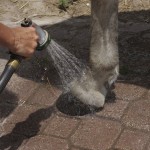by Ray Tricca, Contributions by Dr. Richard Shakalis
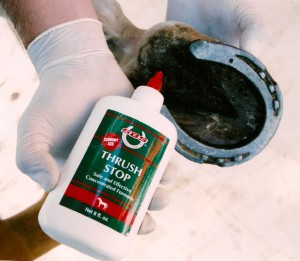
Only SBS Thrush Stop defeated the most chronic cases of thrush that nothing else could touch!
The Horse-Journal published the results of field trials on the leading thrush remedies in their December 2009 issue. They said that cleaning the feet and removing diseased tissue from the clefts are the necessary first steps in treating the cause of thrush, regardless of the commercial thrush products that may be used. In doing research for this article, we discussed the subject of thrush infections with many experienced horse owners and were surprised to discover how many of them never took the time to clean the hoof before applying a thrush medication or remedy. Few knew the cause of horse thrush or how to treat it.
How serious is the thrush on a horse’s feet? The Horse-Journal defines the severity of thrush in three stages:
Stage 1, Mild Thrush: The Horse-Journal said that most of the thrush remedies they tested during the field trials were effective against mild thrush. Mild thrush is often recognized by its obvious black discharge and odor with no deep tissue layer invasions. There is no pain or lameness observed from the hoof. Mild thrush sits near the surface and is easy to kill, sometimes with one application of a cleaning agent.
Stage 2, Moderate Thrush: Moderate thrush has the black discharge and odor along with some pain observed coming from the heel tissue. This is usually an indication of a more deeply rooted infection. The Horse-Journal said that copper and iodine based products work well on moderate thrush, but they can also be caustic to tender tissues and slow healing.
Stage 3, Severe Thrush: There is severe pain and lameness associated with severe thrush with the involvement of deep tissue. Severe thrush is chronic when it is so deeply rooted that it becomes difficult to kill microbes without harming surrounding tissue. Repeated attempts to kill chronic, or deeply rooted infections with traditional ingredients, most of which are caustic, were shown in the field trials not to be very effective against severe thrush.
At the conclusion of the study, the The Horse-Journal said that only one product, SBS Thrush Stop, defeated some chronic cases of thrush that nothing else could touch, yet was gentle to tender hoof tissue. They repeated the test weeks later on chronic cases and came up with similar results. They liked the way the product formed a barrier and had a long-lasting effect. The Horse-Journal said, “Thrush Stop is our No. 1 choice for thrush”. They were so impressed with the results of the product, they named it a “Product Of The Year” for 2009.
Contrary to popular belief some people wondered, how could a product be strong enough to kill this nasty strain of deeply rooted chronic thrush without harming tender hoof tissue? We asked the researchers who developed Thrush Stop for their secret? It is a human interest story that may provide a clue on how to successfully defeat chronic thrush and other deeply rooted infections as well, including while line disease.
Necessity is the Mother of Invention.
Many years ago, Dr. Richard Shakalis went to pick up his daughter at the local horse farm after her training session was over. Like many other young girls her age, she was responsible for grooming her own horse. The stable manager said that her horse had a stubborn case of thrush and recommended that his daughter use one of commercial products that they kept around the barn.
When Dr. Shakalis read the ingredients on the labels, he realized that many were caustic, hazardous, or ineffective against bacteria. He said “there must be a 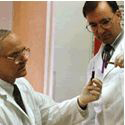 better alternative,” so Dr. Shakalis went to his lab, and with his business associate, Dr. John Pautienis, they formulated a thrush remedy that was both safe and effective. The remedy was such a hit at the barn and the near by horse farms that they formed a new company called SBS EQUINE to manufacture and distribute the product they called Thrush Stop. That was over 30 years ago!
better alternative,” so Dr. Shakalis went to his lab, and with his business associate, Dr. John Pautienis, they formulated a thrush remedy that was both safe and effective. The remedy was such a hit at the barn and the near by horse farms that they formed a new company called SBS EQUINE to manufacture and distribute the product they called Thrush Stop. That was over 30 years ago!
How the thrush treatment works! The objective of Dr. Shakalis and his research team was to target deeply rooted thrush without harming the surrounding hoof tissue. Caustic agents kill microbes, but they can also hinder the hoofs natural defense which is tissue rejuvenation. A normal hoof will grow 3/8” in a month. Thrush in a horse’s hoof is more of a bacterial infection than a fungus. They knew that bacteria thrive in moist environments that is dark and low in oxygen. The clefts of the frog are the perfect place for the bacteria to hide because they are often packed with muck and urine soaked manure.
In simple terms, the formula they developed works in the following way: The key active ingredients target the bacteria and fungi reproductive system so that they can’t reproduce. As a result they die out naturally and quickly, without harming the surrounding tissue. Being a non-caustic formula allows the healthy tissue to thrive and prosper. Over-use of products containing caustic agents are harmful to tender new tissue and hinder their growth.
Other ingredients in the formula form an anticeptic barrier against infection that binds to hoof protein for long lasting protection. The formula also contains a drying agent which helps destroy the moist environment where microbes tend to hide. The long twist cap get the ingredients deep into these crevices where organisms thrive. Aerosols, creams, and powders sit on the surface and are not as effective at penetrating deep into the diseased filled clefts of the frog.
Summary
Chronic thrush is deeply rooted and is impossible to kill with one application of a strong topical agent. Repeated use of these strong chemicals can be harmful to the surrounding healthy hoof tissue and slow the healing process. The SBS researchers developed a formula that targets bacteria and fungi without harming sensitive hoof tissue. The product is not caustic and can be used as often as necessary to keep thrush under control and allow hoof tissue to thrive and prosper.
Regardless of the thrush remedy that is used, the most important steps in dealing with thrush are cleaning and trimming. Removing the diseased tissue and opening up the flaps of the frog by a farrier will give a horse a head start to recovery. Improperly trimmed hoofs prevent oxygen from getting in the crevices. Frequent cleaning can help keep thrush and white line disease under control. Being consistent is the key.
Four steps for treating deeply rooted thrush:
1.Wash the Hoof 2. Pick & Brush 3. Wipe & Dry 4. Apply Thrush Stop
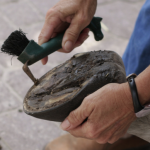
Step 2
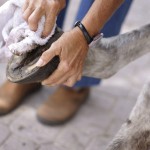
Step 3
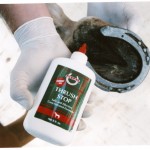
Step 4

Only one product defeated the most chronic cases of thrush that nothing else could touch!
4. Apply Thrush Stop
Contact: Our Friendly Staff
SBS EQUINE
340 9th St North, Ste 86
Naples, Florida 34102
Phone: 239-354-3361
Email: [email protected]
Website: wwwsbsequine.com

